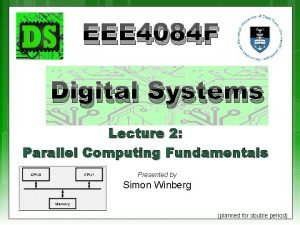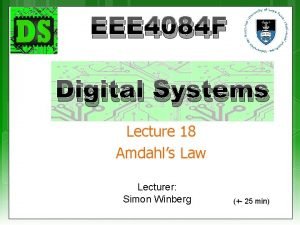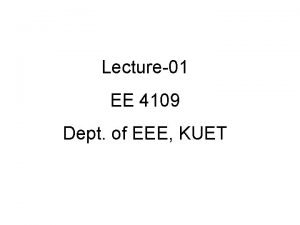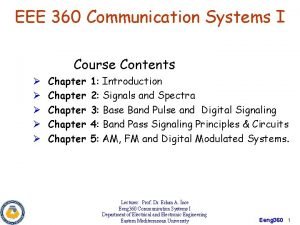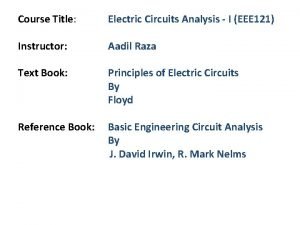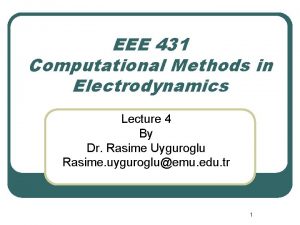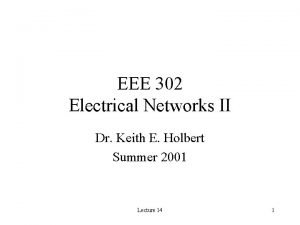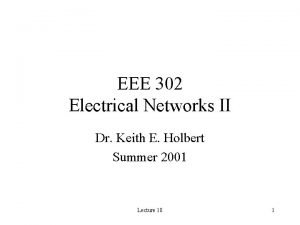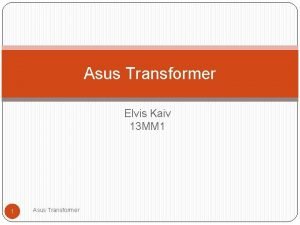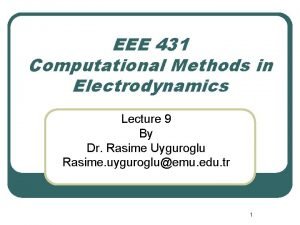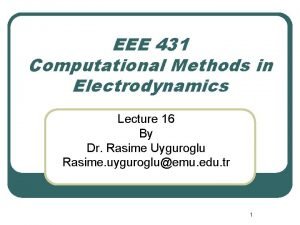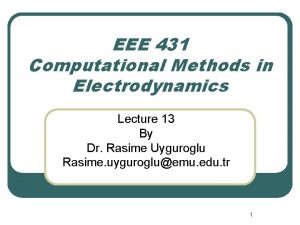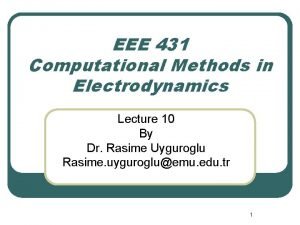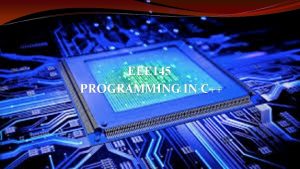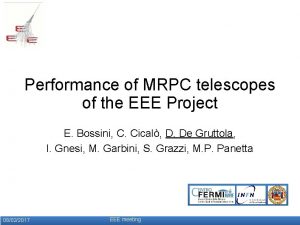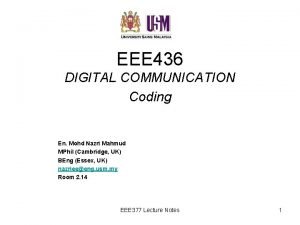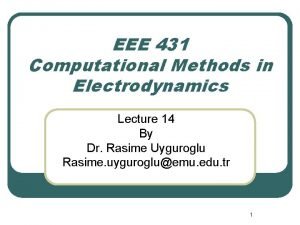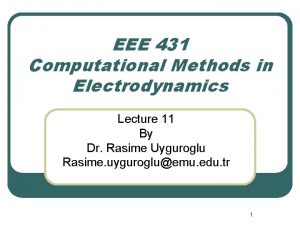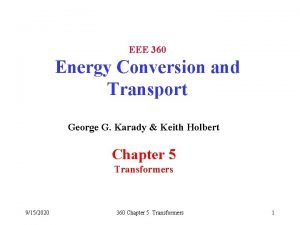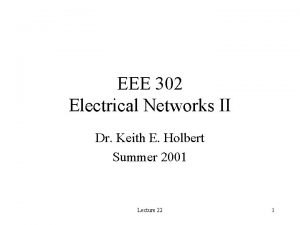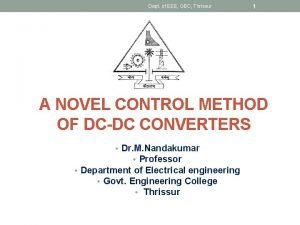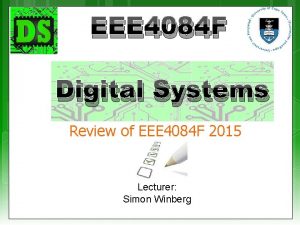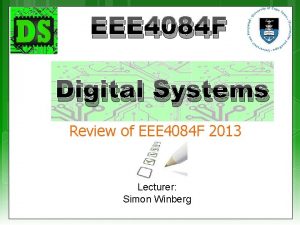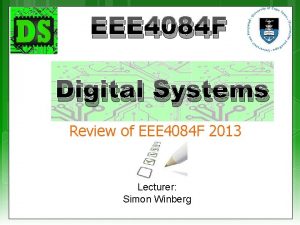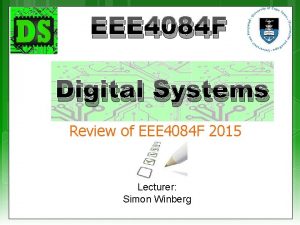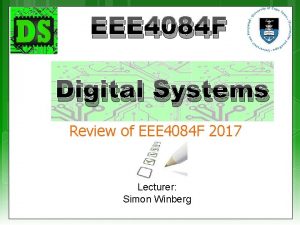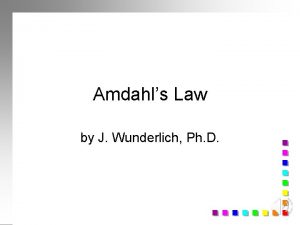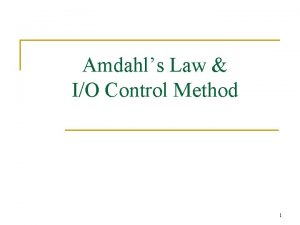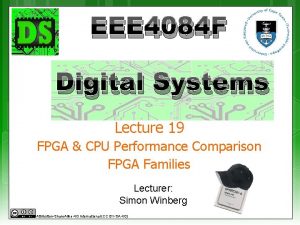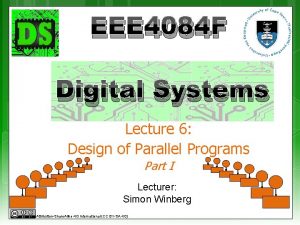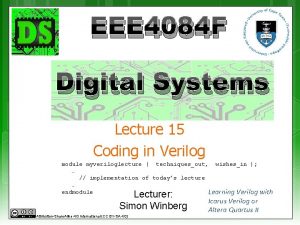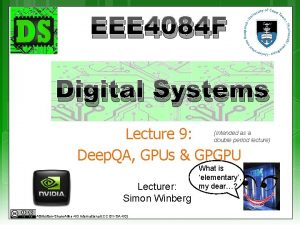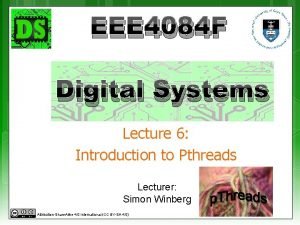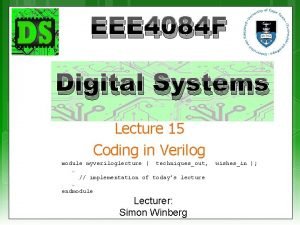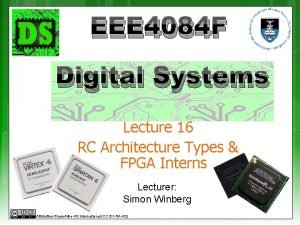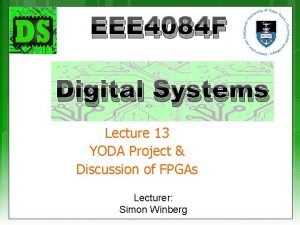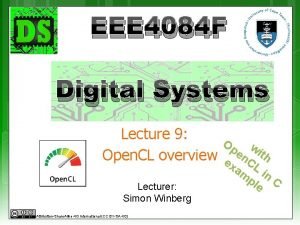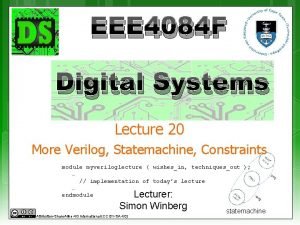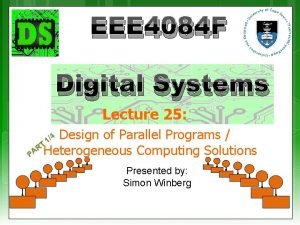EEE 4084 F Digital Systems Lecture 18 Amdahls























- Slides: 23

EEE 4084 F Digital Systems Lecture 18 Amdahl’s Law & YODA Blog & Design Review Lecturer: Simon Winberg

Lecture Overview Yoda phase 1 & 2 Amdahl’s Law

Yoda Phase 1 & 2 Phase Due today (24 April) Phase 10 1: Blog assignment 2: Design Review: May (fixed due date!)

Benefits & Drawbacks to this revised approach…

Main Drawbacks: • Have to spend more time sooner to get this done for the project… • Less implementation work and more design work Advantages (lots): • The report will be implemented as: revised version of design review documents + some results from trials on simulator (or on hardware if you manage to get it working) • Implementations running on a FPGA aren’t needed for the design review. • Due to time considerations the final project may have to be mostly simulated (e. g. using ISIM) instead of getting anything running on the hardware (this would be acceptable – but try to make to get a good demo together that shows graphs) Why? ECSA evaluations need to be in by 24 May.

Phase 1 This blog must: Define the problem and suggested solution. Describes the chosen design problem and digital accelerator product concept that could potentially solve the indicated problem. Briefly described the digital application accelerator that you propose to solve the problem with. Problem list/design questions to be solve. Provide a short list of design problems relevant to the digital application accelerator you have chosen to develop. Reason about the engineering problem, components and processes needed to formulate the solution (provide a point form list in your blog that documents these considerations). Identify suitable criteria for an acceptable solution. Specify (e. g. list of points) what will constitute an acceptable solution to this proposed design project. Examples of criteria include performance (e. g. speed, latency, throughput) and resources used.

Phase 1 This blog must: Define the problem and suggested solution. Describes the chosen design problem and digital accelerator product concept that could potentially solve the indicated problem. Briefly described the digital application accelerator that you propose to solve the problem with. Problem list / design questions to be solve. Provide a short list of design problems relevant to the digital application accelerator you have chosen to develop. Reason about the engineering problem, components and processes needed to formulate the solution (provide a point form list in your blog that documents these considerations). Identify suitable criteria for an acceptable solution. Specify (e. g. list of points) what will constitute an acceptable solution to this proposed design project. Examples of criteria include performance (e. g. speed, latency, throughput) and resources used.

Phase 1 This blog must: Define the problem and suggested solution. Describes the chosen design problem and digital accelerator product concept that could potentially solve the indicated problem. Briefly described the digital application accelerator that you propose to solve the problem with. Problem list / design questions to be solve. Provide a short list of design problems relevant to the digital application accelerator you have chosen to develop. Reason about the engineering problem, components and processes needed to formulate the solution (provide a point form list in your blog that documents these considerations). Identify suitable criteria for an acceptable solution. Specify (e. g. list of points) what will constitute an acceptable solution to this proposed design project. Examples of criteria include performance (e. g. speed, latency, throughput) and resources used.

Phase 2: Design Review Identify information sources used in coming up with the proposed design. This can be presented as a list of references using a bibliography referencing standard such as Harvard or APA. At least 10 references should be provided. [1. 1 b] Example: [1] Bloggs, J. [2010]. “How to do references” In Journal of Writing Styles. 1(2). June 2010. pp 10 -20.

Phase 2: Design Review Identify the important skills needed to complete the YODA project (e. g. , schematic design, HDL programming, C programming, using Linux, etc). Think broadly (no need to be very specific, e. g. understanding bubble sort is too specific). Provide ± 200 words of description for this. [1. 1 b]

Phase 2: Design Review Describe the methodology that you will follow to develop the proposed YODA product. Your description needs to show two approaches: the second approach can be a modified (or simplified) version of the first approach (i. e. think of this in terms of a Plan A and Plan B, where Plan A presents a potentially more involved and timecostly approach, and Plan B a risk-reduced approach that could be used if Plan A fails). Presented in the form: project objective identified design problems proposed solution evaluation process. Add a process diagram to illustrate the steps of this methodology. [1. 1 c]

Phase 2: Design Review Modelling and analysis. Present a (draft) model of your YODA product design. This can be in the form of a paperbased (or digital) block diagram or UML model. Prepare a PC -based golden measure for your YODA accelerator: this can be implemented using Mat. Lab, Octave, Python, C or C++, or a combination of these languages.

Phase 2: Design Review Evaluate your design solutions using paper-based calculations, such as algorithm complexity calculations (e. g. big-O execution time performance of your solutions) and estimations of other performance criteria. These calculations need to be documented in your design review report submitted for this phase of the project. This must be done for both the PC-based golden measure and your proposed FPGA-based YODA design. Write a description of the evaluation steps that will be carried out to evaluate the performance.

Speed-up Number of processors Amdahl’s Law EEE 4084 F

Amdahl’s Law: History The guy: Gene Amdahl Was chief architect for IBM's first mainframe series of computers Founder of Amdahl Corporation Amdahl found stringent restrictions on the speedup possible for given parallelized tasks. Thee observations packaged as: Amdahl's Law

Video Clip… Linux Magazine Video: Understanding Parallel Computing: Amdahl's Law

Cl as sic Amdahl’s Law ve rsi on Define f as: fraction of computation that can be parallelized (ignoring scheduling overhead) Then (1 - f ) is the fraction that is sequential Define n = no. processors for parallel case The maximum speed-up achievable is: Speedupparallel = 1 (1–f)+ f n Should be able to remember this formula for exams

Amdahl’s Law: Alternate Representation P = expected performance improvement Eu = Execution time on a uniprocessor (serial) Ep = Execution time on a number of processors (parallel) n = number of processors S = fraction of time spent in the sequential time

Calculating using the BCE A great many papers on the subject of Amdahl’s law Many mention the term BCE = Base Core Equivalent A single processing core in a multicore processor design

Example proc. structures Symmetric multicore 16 one-BCE cores Symmetric multicore 4 x 4 -BCE cores Asymmetric multicore comprising 2 x 4 -BCE cores + 8 x 1 -BCE cores

Amdahl’s Law Calculator Check out Hill and Marty’s Amdahl’s interactive grapher at: http: //research. cs. wisc. edu /multifacet/amdahl/ You can also download the OCTAVE / Matlab code to do these graphs! Quiz example of resultant graph…

Example run of Hill and Marty’s Amdahl’s interactive grapher:

Reading Hill and Marty 2008: “Amdahl’s Law in the Multicore Era” Available: http: //research. cs. wisc. edu/multifacet/papers/ieeecomputer 08_ (see Vula) Good article on Wikipedia look over: amdahl_multicore. pdf http: //en. wikipedia. org/wiki/Amdahl's_law
 Q6 4084
Q6 4084 Amdahl law calculator
Amdahl law calculator 01:640:244 lecture notes - lecture 15: plat, idah, farad
01:640:244 lecture notes - lecture 15: plat, idah, farad Eee kuet
Eee kuet Eee 360
Eee 360 Ankara university
Ankara university Eee 121
Eee 121 Eee 431
Eee 431 Eee 302
Eee 302 Eee 302
Eee 302 Tahvel.edu.eee
Tahvel.edu.eee Eee 431
Eee 431 Eee 431
Eee 431 Eee 431
Eee 431 Eee 431
Eee 431 Eee 145
Eee 145 Eee
Eee Lempel-ziv coding in digital communication
Lempel-ziv coding in digital communication Eee 431
Eee 431 Eee 431
Eee 431 Eee g
Eee g Quality factor of rlc circuit
Quality factor of rlc circuit Dot product
Dot product Eee
Eee
